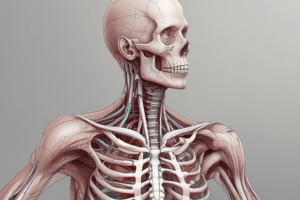Podcast
Questions and Answers
What is the average femoral torsion angle?
What is the average femoral torsion angle?
- 8 degrees
- 250 degrees
- 120 degrees (correct)
- 180 degrees
Retroversion of the femoral shaft causes the patella to point medially.
Retroversion of the femoral shaft causes the patella to point medially.
False (B)
What is the most common acute orthopedic injury in the geriatric population?
What is the most common acute orthopedic injury in the geriatric population?
Hip fracture
Femoral torsion angles range from ___ to ___ degrees.
Femoral torsion angles range from ___ to ___ degrees.
Which type of hip fracture is considered the least severe?
Which type of hip fracture is considered the least severe?
Women are less likely to experience hip fractures compared to men.
Women are less likely to experience hip fractures compared to men.
What type of femoral torsion angle is associated with 'toeing in'?
What type of femoral torsion angle is associated with 'toeing in'?
95% of hip fractures result from falls that occur ___.
95% of hip fractures result from falls that occur ___.
Match the following types of hip fractures with their description:
Match the following types of hip fractures with their description:
Flashcards are hidden until you start studying
Study Notes
Femoral Torsion Angles
- The femoral torsion angle is the angle between the femoral condyles and the axis of the femoral neck.
- A normal angle means the patella faces forward, ranging from 8-25 degrees, averaging 12 degrees.
- Anteversion is an increased angle, causing the femoral shaft to rotate medially, resulting in "toeing in" and the patella pointing more medially.
- Retroversion is a decreased angle, causing the femoral shaft to rotate laterally, resulting in "toeing out" and the patella pointing more laterally.
Hip Fractures
- Over 300,000 hip fractures occur annually.
- The cost of treatment is over $10 billion.
- Over 95% of hip fractures are caused by falls, most often from a sideways fall.
- Elderly women are more susceptible to hip fractures, due to a higher incidence of osteoporosis.
- Hip fractures are the most common orthopedic injury in older adults.
- The location and severity of the fracture affect surgical management and physical therapy intervention.
Hip Fracture Severity
- Hip fractures can be classified as:
- Simple: Least severe.
- Displaced: Moderate severity.
- Comminuted: Most severe.
Hip Fracture Location
- Hip fractures can occur in different locations:
- Extracapsular or Intertrochanteric: Along the trochanter.
- Intracapsular: Within the joint capsule.
- Subcapital: Below the femoral head.
- Femoral neck: Including a transcervical fracture.
- Subtrochanteric: In the proximal femoral shaft.
Studying That Suits You
Use AI to generate personalized quizzes and flashcards to suit your learning preferences.




